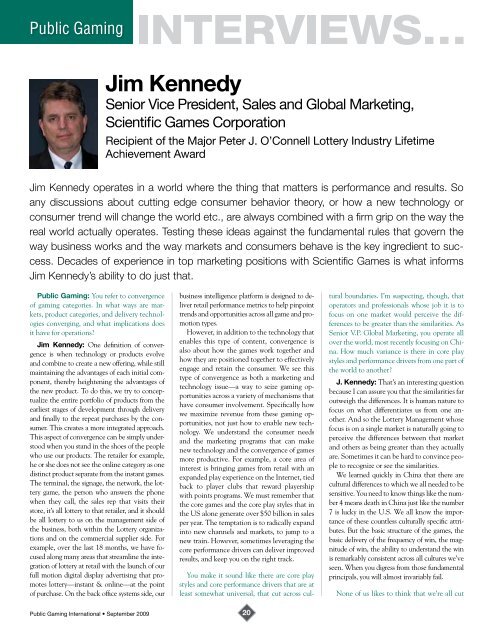The regular .pdf file can be viewed here. - Public Gaming Research ...
The regular .pdf file can be viewed here. - Public Gaming Research ...
The regular .pdf file can be viewed here. - Public Gaming Research ...
You also want an ePaper? Increase the reach of your titles
YUMPU automatically turns print PDFs into web optimized ePapers that Google loves.
<strong>Public</strong> <strong>Gaming</strong><br />
Jim Kennedy<br />
Senior Vice President, Sales and Global Marketing,<br />
Scientific Games Corporation<br />
Recipient of the Major Peter J. O’Connell Lottery Industry Lifetime<br />
Achievement Award<br />
Jim Kennedy operates in a world w<strong>here</strong> the thing that matters is performance and results. So<br />
any discussions about cutting edge consumer <strong>be</strong>havior theory, or how a new technology or<br />
consumer trend will change the world etc., are always combined with a firm grip on the way the<br />
real world actually operates. Testing these ideas against the fundamental rules that govern the<br />
way business works and the way markets and consumers <strong>be</strong>have is the key ingredient to success.<br />
Decades of experience in top marketing positions with Scientific Games is what informs<br />
Jim Kennedy’s ability to do just that.<br />
<strong>Public</strong> <strong>Gaming</strong>: You refer to convergence<br />
of gaming categories. In what ways are markets,<br />
product categories, and delivery technologies<br />
converging, and what implications does<br />
it have for operations?<br />
Jim Kennedy: One definition of convergence<br />
is when technology or products evolve<br />
and combine to create a new offering, while still<br />
maintaining the advantages of each initial component,<br />
t<strong>here</strong>by heightening the advantages of<br />
the new product. To do this, we try to conceptualize<br />
the entire portfolio of products from the<br />
earliest stages of development through delivery<br />
and finally to the repeat purchases by the consumer.<br />
This creates a more integrated approach.<br />
This aspect of convergence <strong>can</strong> <strong>be</strong> simply understood<br />
when you stand in the shoes of the people<br />
who use our products. <strong>The</strong> retailer for example,<br />
he or she does not see the online category as one<br />
distinct product separate from the instant games.<br />
<strong>The</strong> terminal, the signage, the network, the lottery<br />
game, the person who answers the phone<br />
when they call, the sales rep that visits their<br />
store, it’s all lottery to that retailer, and it should<br />
<strong>be</strong> all lottery to us on the management side of<br />
the business, both within the Lottery organizations<br />
and on the commercial supplier side. For<br />
example, over the last 18 months, we have focused<br />
along many areas that streamline the integration<br />
of lottery at retail with the launch of our<br />
full motion digital display advertising that promotes<br />
lottery—instant & online—at the point<br />
of purchase. On the back office systems side, our<br />
business intelligence platform is designed to deliver<br />
retail performance metrics to help pinpoint<br />
trends and opportunities across all game and promotion<br />
types.<br />
However, in addition to the technology that<br />
enables this type of content, convergence is<br />
also about how the games work together and<br />
how they are positioned together to effectively<br />
engage and retain the consumer. We see this<br />
type of convergence as both a marketing and<br />
technology issue—a way to seize gaming opportunities<br />
across a variety of mechanisms that<br />
have consumer involvement. Specifically how<br />
we maximize revenue from these gaming opportunities,<br />
not just how to enable new technology.<br />
We understand the consumer needs<br />
and the marketing programs that <strong>can</strong> make<br />
new technology and the convergence of games<br />
more productive. For example, a core area of<br />
interest is bringing games from retail with an<br />
expanded play experience on the Internet, tied<br />
back to player clubs that reward playership<br />
with points programs. We must remem<strong>be</strong>r that<br />
the core games and the core play styles that in<br />
the US alone generate over $50 billion in sales<br />
per year. <strong>The</strong> temptation is to radically expand<br />
into new channels and markets, to jump to a<br />
new train. However, sometimes leveraging the<br />
core performance drivers <strong>can</strong> deliver improved<br />
results, and keep you on the right track.<br />
You make it sound like t<strong>here</strong> are core play<br />
styles and core performance drivers that are at<br />
least somewhat universal, that cut across cultural<br />
boundaries. I’m suspecting, though, that<br />
operators and professionals whose job it is to<br />
focus on one market would perceive the differences<br />
to <strong>be</strong> greater than the similarities. As<br />
Senior V.P. Global Marketing, you operate all<br />
over the world, most recently focusing on China.<br />
How much variance is t<strong>here</strong> in core play<br />
styles and performance drivers from one part of<br />
the world to another?<br />
J. Kennedy: That’s an interesting question<br />
<strong>be</strong>cause I <strong>can</strong> assure you that the similarities far<br />
outweigh the differences. It is human nature to<br />
focus on what differentiates us from one another.<br />
And so the Lottery Management whose<br />
focus is on a single market is naturally going to<br />
perceive the differences <strong>be</strong>tween that market<br />
and others as <strong>be</strong>ing greater than they actually<br />
are. Sometimes it <strong>can</strong> <strong>be</strong> hard to convince people<br />
to recognize or see the similarities.<br />
We learned quickly in China that t<strong>here</strong> are<br />
cultural differences to which we all needed to <strong>be</strong><br />
sensitive. You need to know things like the num<strong>be</strong>r<br />
4 means death in China just like the num<strong>be</strong>r<br />
7 is lucky in the U.S. We all know the importance<br />
of these countless culturally specific attributes.<br />
But the basic structure of the games, the<br />
basic delivery of the frequency of win, the magnitude<br />
of win, the ability to understand the win<br />
is remarkably consistent across all cultures we’ve<br />
seen. When you digress from those fundamental<br />
principals, you will almost invariably fail.<br />
None of us likes to think that we’re all cut<br />
<strong>Public</strong> <strong>Gaming</strong> International • Septem<strong>be</strong>r 2009 20




